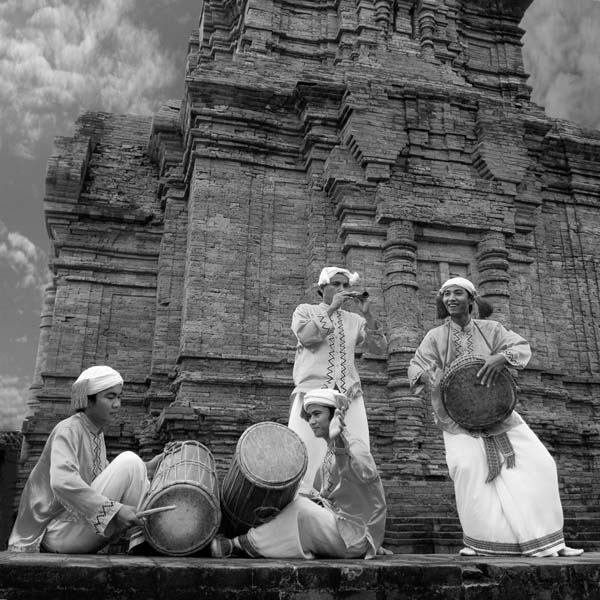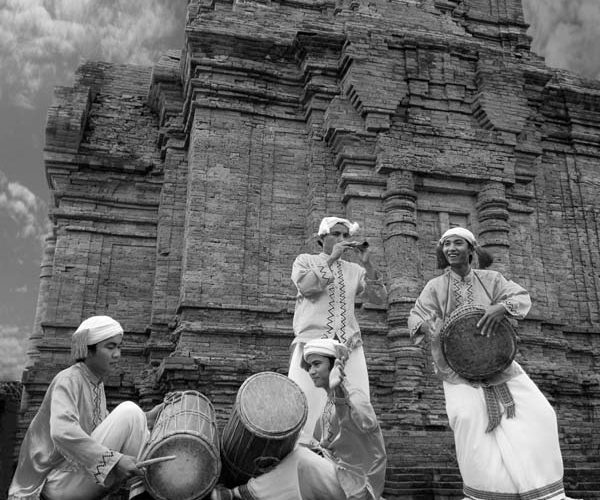(No.4, Vol.8,Aug-Sep Vietnam Heritage Magazine)
A Cham show with gineng drums (left), saranai flute (middle) and baranung drum (right).
Photo: Do Huu Tuan

Cham instruments are an integral part of life and culture
While visiting Cham villages of Ninh Thuan Province, one can not only enjoy and learn about their unique cultural values, festivals, customs and lifestyle, but also study traditional musical instruments that have been passed down through generations.
Cham people use many musical instruments, which normally are divided into three main groups of string, wind and rhythm instruments. Among them the most popular are perhaps the gineng drums, baranung drums and saranai flute.
Gineng drums are oblong, and raised in the middle. The body is about 0.7m long, made of iron wood or Siamese rosewood, smoothly planed both outside and inside. The two faces are unequal. The smaller one, played with the fingers, is covered with goat or deer skin, while the bigger one, played with a stick, uses stretched buffalo skin. Gineng drums always come in a pair, set side by side in tilted position, with drummers sitting in a meditating posture.
To Cham people, the sound of gineng is like a sign from heaven announcing, for example, the coming of the festive season, a happy time for communities. Those who want to play gineng must make offerings, which include eggs, wines and areca, in a ritual called guru kowtow, to the artisan they choose. After that, the artisan would teach them everything from basic sounds to complex rythms. Cham people believe that only those with a serene heart and relaxed mind can make forceful, eloquent sounds, while the narrow-minded, egoistic ones can’t play the drum no matter how hard they try.
Baranung drum is both a musical instrument and the sacred totem of the Maduen (maestro of clap). The drum body is an empty log, 0.4m in diameter, covered with goat or deer skin and stretched by a net of rattan strings and twelve wooden wedges which are used to regulate the sound.
When playing, the drummer sits cross-legged, putting a rim of the baranung drum on his left thigh, his left hand on the drum’s rim both to hold it and to play, and his right hand is free. The techniques include vibrating fingers, covering the drum face with the left palm to make dull sounds, slapping the drum with the whole right hand palm to make a deep sound, or half the palm to make a high sound. So a music piece is a combination of the above techniques applied in a suitable sequence with suitable force of the hands and fingers. Baranung is a simple instrument, but the hardest to play. To master the drum, it takes a long, tedious time to learn under the supervision of the clap maestro Maduen.
Saranai flute is the most special among Cham instruments. It has three connected parts. The base, where the player blows, is made of brass and has a reed made of a kind of palm leaf. The wooden body is a hollow pipe with seven holes at the top and one auxiliary hole at the bottom. The last sound amplifying part looks like a funnel and is made of precious wood, buffalo horn or ivory.
Cham music traditions developed very early. Music has been tightly attached to the community life, culture and belief. An even more interesting fact is that Cham people consider the gineng drum, baranung drum and saranai flute as representing the parts of human body. The gineng symbolizes the legs, baranung the torso, and saranai the head. Therefore they must always be played together in the complete set.

